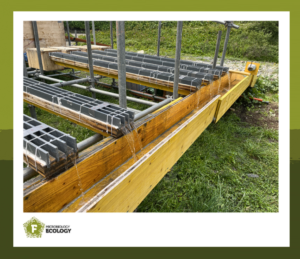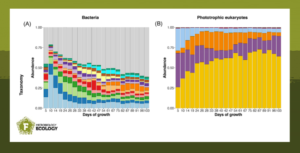Glacier-fed streams, formed by seasonal meltwater from glaciers, supply freshwater to downstream ecosystems and human populations. As these glacier-fed streams are dominated by biofilms, the inhabiting microbial communities suffer from conditions related to climate change. The study “Experimental evidence on the impact of climate-induced hydrological and thermal variations on glacier-fed stream biofilms” in FEMS Microbiology Ecology aimed to understand how microbial biofilms in glaciers respond to climate-induced changes. For today’s World Day for Glaciers, David Touchette explains how microbial activities potentially impact these vital ecosystems, global food webs and water supplies. #MicrobiologyEvents
Microbial biofilms thrive in glacier-fed streams
Glacier-fed streams are quite extreme; they often have low nutrient concentrations, very cold temperatures, and high sediment loads. They change rapidly, both daily and seasonally, from being covered by snow in the winter, to being exposed to high ultraviolet radiation in the summer. These streams also experience shifts in water flow due to snowmelt, glacier melt, and groundwater.
Despite these harsh conditions, complex microbial communities build biofilms on streambeds, including stones, pebbles, and sediments. These protective biofilms harbour members from all domains of life, play key roles in nutrient cycling, and form the basis of the food web in stream ecosystems. Their success lies in the microbes’ abilities to adapt and withstand to the dynamic environment.
However, climate change is expected to alter the natural cycles in glacier-fed streams, with warming stream temperatures and more unpredictable flow regimes, including drought events. These shifts threaten water security by disrupting favourable environmental conditions for microbes to grow biofilms. Yet, how these changes affect microbial communities in glacier-fed streams remains poorly understood.
Drought-like periods impact glacial stream biofilms
To better understand how biofilms respond to climate-induced changes, the study “Experimental evidence on the impact of climate-induced hydrological and thermal variations on glacier-fed stream biofilms” in FEMS Microbiology Ecology, constructed artificial streams, so-called mesocosms, in the Swiss Alps to grow glacier stream biofilms over a span of 100 days.

The study replicated biofilms as found in natural glacier-fed streams. These harboured the same dominant microbial taxa, including Rhodoferax, Methylotenera, Polaromonas, Hydrurus, and Diatoma, and their typical succession pattern. Moreover, the experimental biofilm communities differed from the nearby stream water communities, indicating a successful establishment of specialised biofilms.
These experimental biofilms were exposed to varying hydrological and thermal conditions to simulate climate change scenarios. Drought-like conditions significantly impacted microbial biofilms and led to considerable shifts in the communities, favouring taxa normally found in soils. Additionally, drought-tolerant species, such as Sphingomonas, Nocardioides, Massilia, and Hymenobacter, were able to successfully compete and grow drought-stressed biofilms.
Their tolerance to drought is likely linked to their abilities to produce extracellular polymeric substances. These substances help retain water within the biofilm matrix, mitigating the negative effects of drought conditions.
Climate change scenarios decrease algal biomass in glacier-fed stream biofilms
Under climate change, glacier-fed streams are expected to become “greener” due to reduced glacier meltwater input and turbidity. In this study, both warming and drought conditions led to reduced chlorophyll levels within the biofilms, suggesting a decrease in algal biomass.
This result could be attributed to several mechanisms. Both warming and droughts may stimulate the activity of protozoa predators that feed on algae, leading to smaller algal populations.
Alternatively, these environmental conditions might directly induce algal mortality. For example, drought can induce osmotic stress which alters both the photosynthesis apparatus and the membranes.
-

Microbial compositions of glacial biofilms. From Touchette et al. (2024).
Lastly, pigment reshuffling could result in reduced algal chlorophyll levels. For example, in response to stress, algae may favour producing carotenoids over chlorophyll as an adaptive strategy.
Taken together, these findings suggest that climatic pressures not only affect the composition of microbial communities but could also reduce primary production and carbon fixation in glacier-fed stream ecosystems. This decrease may lower autochthonous carbon production within the stream, disrupting the food web by affecting biofilm metabolism. Given the role of biofilms in water filtration and purification, such disruptions may have cascading effects on the quality of freshwater originating in glaciers and snowmelt. Happy World Day for Glaciers!
- Read the article “Experimental evidence on the impact of climate-induced hydrological and thermal variations on glacier-fed stream biofilms” in FEMS Microbiology Ecology by Touchette et al. (2024).
About the author
 David Touchette is a PhD student in the River Ecosystems Laboratory at the EPFL (Sion, Switzerland). In his current and past research at McGill University (Montréal, Canada), he investigates microbial communities inhabiting the cryosphere across various environments, including soil, snow, water, and biofilms. Combining field expeditions to remote areas such as the Canadian Arctic, the Swiss Alps, and Svalbard with laboratory work, his studies focus on how these communities thrive in extreme conditions and adapt to climate change.
David Touchette is a PhD student in the River Ecosystems Laboratory at the EPFL (Sion, Switzerland). In his current and past research at McGill University (Montréal, Canada), he investigates microbial communities inhabiting the cryosphere across various environments, including soil, snow, water, and biofilms. Combining field expeditions to remote areas such as the Canadian Arctic, the Swiss Alps, and Svalbard with laboratory work, his studies focus on how these communities thrive in extreme conditions and adapt to climate change.
About this blog section
The section #MicrobiologyEvents for the #FEMSmicroBlog reports about events and meetings relevant to our network. These include world awareness days, FEMS-sponsored meetings or meetings of Member Societies and many more.
| DO YOU WANT TO BE A GUEST CONTRIBUTOR? |
| The #FEMSmicroBlog welcomes external bloggers, writers and SciComm enthusiasts. Get in touch if you want to share your idea for a blog entry with us! |
